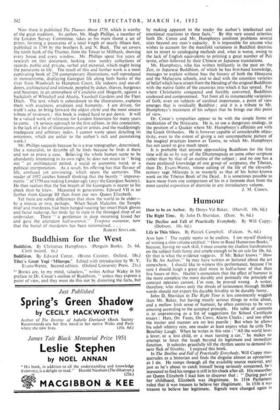True Topography
IF my best shoes are of standard length, and if my arithmetic is less dusty than my shoes, exactly 196 feet of shelving in the London Library are devoted to books about London. There must be more than 1,500 volumes. Yet all the information about London which is accurate, unduplicated and worth one's time to read would surely fit into fifty books, or three per cent. of the whole. Then why do all the rest exist, not only there but in the other distinguished libraries of the world, solemnly vacuum-cleaned at intervals by the harnessed forces of a puzzled Nature so that the dust to which most of the authors have turned may be kept away from the leaves they left behind ? The answer is not the word " royalties," for the holes in a topographer's shoes, believe me, are as often an index to his bank-balance as to his perambulation. The answer must lie in a mixture of the vanity of writing, the craving to serve one's generation (a Siamese twin of the foregoing), and a romantic obsession with the largest thing in the Englishman's universe, the accretion left behind as in a cosmic pawnshop by more English people than have ever assembled anywhere else : the accretion is called London, therefore London is celebrated with a vomit of words.
Fortunately a few topographers have set and maintained a great tradition. They do not rhapsodise, but relate. They are well known : grandfather Stow, who peered round every street-corner like a jealous shopkeeper ; the assiduous Strype, now sleeping under his flat stone—the most distinguished tomb in London (go and see it—and, in order to qualify as a discoverer and not a mere book-looker, pray find out first by your own gumption where it lies) ; Samuel Lewis, the historian of Islington ; Faulkner of Kensington and Chelsea. In recent times the topographer has been elbowed away ley the romancer, whose eyes are fixed on the beckoning Gorgon of the lending libraries.- But there have been valiant exceptions, even when Charles Booth invented a kind of anthropo- logical topography, as he moved from the garret of the flower-girl to the alcove of the wife-beater.
Now there is published The Thames About 1750, which is worthy of the great tradition. Its author, Mr. Hugh Phillips, a member of the London Survey Committee, takes as his main theme a set of prints, forming a panorama of a total length of nearly fifteen feet, published in 1749 by the brothers S. and N. Buck. The set covers the north bank of the Thames, from the Tower to Millbank, showing every house and every window. Mr. Phillips spent five years of research on this document, looking into sundry collections of records, public and private, verbal and pictorial, which might bring the panorama to life. The result of this and further work is a most captivating book of 258 contemporary illustrations, well reproduced in monochrome, displaying Georgian life along both banks of the river from Woolwich to Hampton Court, life indoors and out-of- doors, architectural and intimate, peopled by dukes, thieves, burgesses and boatmen, in an atmosphere of Canaletto and Hogarth, against a backcloth of Whitehall and Alsatia, Vauxhall Gardens and the Fleet Ditch. The text, which is subordinate to the illustrations, explains them with exactness, erudition and humanity. I am driven, for truth's sake, to bring forward the oldest cliché and the most sincere tribute of reviewers : this book is indeed hard to put down. It will be a valued work of reference for London historians for many years to come. (A serious reproach to the first edition: in this connection, is the lack of a list of illustrations and/or artists, and the maddeningly inadequate and arbitrary index. I cannot waste space detailing its omissions, which are unfair to the author's rich and painstaking work.) Mr. Phillips succeeds because he is a true topographer, determined, like a naturalist, to describe all he finds because he finds it there and not to prove a case. Believing the whole human scene to be abundantly interesting in its own right, he does not strain to " bring out " an architectural period, a social or economic trend, or a political interpretation. As a result, his offering has that flavour of life, confused yet convincing, which spans the centuries. The reader of 1952 catches himself thinking that the beastly • • improve- ments " of 1750 are making London ugly (pace the Georgian Society). He then realises that the hot breath of the Georgians is nearer to his cheek than he knew. Measured in generations, Edward VII is no further from George III than from our new Queen Elizabeth.
Yet there are subtle differences that show the world to be older— by a minute or two, perhaps. When Sarah Malcolm, the Temple thief and murderess, had been hanged wearing her smart black gloves and facial make-up, her body lay in state in the thronged shop of an undertaker. There " a gentleman in deep mourning kissed her and gave the attendant half-a-crown." Tempora mutantur, now that the burial of murderers has been nationalised.. . .
ROBERT SINCLAIR.











































 Previous page
Previous page